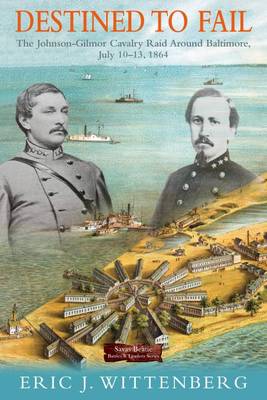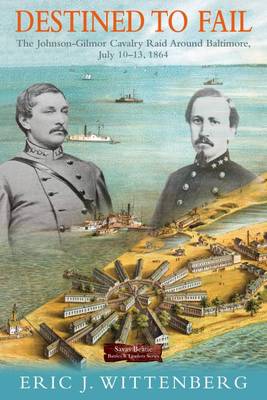
Je cadeautjes zeker op tijd in huis hebben voor de feestdagen? Kom langs in onze winkels en vind het perfecte geschenk!
- Afhalen na 1 uur in een winkel met voorraad
- Gratis thuislevering in België vanaf € 30
- Ruim aanbod met 7 miljoen producten
Je cadeautjes zeker op tijd in huis hebben voor de feestdagen? Kom langs in onze winkels en vind het perfecte geschenk!
- Afhalen na 1 uur in een winkel met voorraad
- Gratis thuislevering in België vanaf € 30
- Ruim aanbod met 7 miljoen producten
Zoeken
€ 41,95
+ 83 punten
Omschrijving
The Johnson-Gilmor Raid, a gripping tale of desperation and high stakes during the American Civil War, unveils the doomed attempt to free Confederate prisoners of war, shedding light on the intricacies of wartime strategies and the relentless pursuit of liberty.
The Johnson-Gilmor Raid represents one of three major attempts to free prisoners of war during the American Civil War. Like the other two, it was destined to fail for a variety of reasons, mostly because the timetable for the operation was a schedule impossible to meet. The mounted raid was a fascinating act of increasing desperation by the Confederate high command in the summer of 1864, and award-winning cavalry historian Eric J. Wittenberg presents the gripping story in detail for the first time in The Johnson- Gilmor Cavalry Raid Around Baltimore, July 10-13, 1864, the fourth book in the bestselling Battles & Leaders Series.
The thundering high-stakes operation was intended to free the suffering of 15,000 Confederate prisoners held at Point Lookout, Maryland, a peninsula at the confluence of the Potomac River and the Chesapeake Bay. The operation consisted of two mounted columns, one under Bradley Johnson and a second smaller one under Harry Gilmor. Each had different objectives. The former would move directly on Point Lookout, while the other destroyed bridges and created other mischief to tie up enemy forces. (The wild plot initially envisioned launching a simultaneous naval strike, which went awry at the 11th hour.) Success would have released thousands of men behind enemy lines, created significant chaos and, with a little more luck, returned veterans into the fighting ranks.
The fast-paced July 1864 drama has never been told in such depth and with such precision. Wittenberg draws upon a wide variety of sources to do so, including contemporary newspapers. Part of his analysis compares and contrasts this raid to a pair of other unsuccessful attempts to free Union prisoners of war--the Kilpatrick-Dahlgren Raid of February-March 1864, and the Stoneman Raid on Macon, Georgia, of July 1864--as well as Gen. George S. Patton's attempt to free his son-in-law and other American prisoners in March of 1945.
The Johnson-Gilmor Cavalry Raid Around Baltimore will be welcomed by anyone with an interest in the Civil War, high-stakes cavalry operations, or the politics of Civil War high command.
The Johnson-Gilmor Raid represents one of three major attempts to free prisoners of war during the American Civil War. Like the other two, it was destined to fail for a variety of reasons, mostly because the timetable for the operation was a schedule impossible to meet. The mounted raid was a fascinating act of increasing desperation by the Confederate high command in the summer of 1864, and award-winning cavalry historian Eric J. Wittenberg presents the gripping story in detail for the first time in The Johnson- Gilmor Cavalry Raid Around Baltimore, July 10-13, 1864, the fourth book in the bestselling Battles & Leaders Series.
The thundering high-stakes operation was intended to free the suffering of 15,000 Confederate prisoners held at Point Lookout, Maryland, a peninsula at the confluence of the Potomac River and the Chesapeake Bay. The operation consisted of two mounted columns, one under Bradley Johnson and a second smaller one under Harry Gilmor. Each had different objectives. The former would move directly on Point Lookout, while the other destroyed bridges and created other mischief to tie up enemy forces. (The wild plot initially envisioned launching a simultaneous naval strike, which went awry at the 11th hour.) Success would have released thousands of men behind enemy lines, created significant chaos and, with a little more luck, returned veterans into the fighting ranks.
The fast-paced July 1864 drama has never been told in such depth and with such precision. Wittenberg draws upon a wide variety of sources to do so, including contemporary newspapers. Part of his analysis compares and contrasts this raid to a pair of other unsuccessful attempts to free Union prisoners of war--the Kilpatrick-Dahlgren Raid of February-March 1864, and the Stoneman Raid on Macon, Georgia, of July 1864--as well as Gen. George S. Patton's attempt to free his son-in-law and other American prisoners in March of 1945.
The Johnson-Gilmor Cavalry Raid Around Baltimore will be welcomed by anyone with an interest in the Civil War, high-stakes cavalry operations, or the politics of Civil War high command.
Specificaties
Betrokkenen
- Auteur(s):
- Uitgeverij:
Inhoud
- Aantal bladzijden:
- 176
- Taal:
- Engels
- Reeks:
Eigenschappen
- Productcode (EAN):
- 9781611216196
- Verschijningsdatum:
- 17/04/2025
- Uitvoering:
- Hardcover
- Formaat:
- Genaaid
- Afmetingen:
- 149 mm x 221 mm
- Gewicht:
- 371 g

Alleen bij Standaard Boekhandel
+ 83 punten op je klantenkaart van Standaard Boekhandel
Beoordelingen
We publiceren alleen reviews die voldoen aan de voorwaarden voor reviews. Bekijk onze voorwaarden voor reviews.









